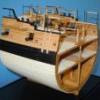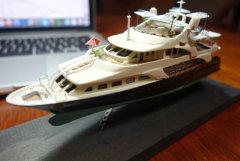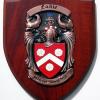-
Posts
2,434 -
Joined
-
Last visited
Reputation Activity
-
 dvm27 got a reaction from cookster in Cutter Cheerful 1806 by rafine - FINISHED
dvm27 got a reaction from cookster in Cutter Cheerful 1806 by rafine - FINISHED
A beautiful model accompanied by beautiful photography. What more could we lurkers ask for? Looking forward to your next build.
-
 dvm27 got a reaction from Canute in HMS Bellerophon 1786 by AON – scale 1:64 – 74-gun 3rd Rate Man of War - Arrogant-Class
dvm27 got a reaction from Canute in HMS Bellerophon 1786 by AON – scale 1:64 – 74-gun 3rd Rate Man of War - Arrogant-Class
Great start Alan. Druxey has a great technique for keeping the chisel perpendicular using the reflection in the mirror finish of the chisel. Perhaps he can elaborate.
-
 dvm27 reacted to mtaylor in Licorne 1755 by mtaylor - 3/16" scale - French Frigate - from Hahn plans - Version 2.0 - TERMINATED
dvm27 reacted to mtaylor in Licorne 1755 by mtaylor - 3/16" scale - French Frigate - from Hahn plans - Version 2.0 - TERMINATED
Thanks for the comments and the "likes"...
Here's the rudder ready to hang. Once the cudgeons are on the hull, I'll add the rudder coat and mount it. I'll probably pin it to the sternpost from the inside of the hull just to keep it in place as I'll be flipping the hull over a few more times before cutting it loose and mounting it to a cradle.
I made a judgement call after testing on some scrap about the bolts. Not going to happen. If the bolts are visible, they're oversize by an order of magnitude. If' they're just the right size, they're invisible.
I also did some testing to compare Jax Black to Birchwood Casey Black. Not much difference except maybe the Birchwood Casey is a bit blacker and also seems to cover silver solder better.
Been a busy of testing this stuff.
Ok.. pictures.....
First piccy shows the old and the new together. I'm happier with the new and the old is hitting the scrap box. The second pic has a dummy sternpost next to it. I've got a big smile on that one.
-
 dvm27 got a reaction from WackoWolf in Sovereign of the Seas 1637 by modelshipwright (Bill Short) - Sergal - 1:78 - Port "as built", Starboard "as presented to King Charles I for approval"
dvm27 got a reaction from WackoWolf in Sovereign of the Seas 1637 by modelshipwright (Bill Short) - Sergal - 1:78 - Port "as built", Starboard "as presented to King Charles I for approval"
Welcome back, Bill. Thanks for sharing a current photo of your beautiful model.
-
 dvm27 reacted to Mahuna in Dunbrody by Mahuna - FINISHED - 1:48 - Cross-Section - Irish Famine Ship
dvm27 reacted to Mahuna in Dunbrody by Mahuna - FINISHED - 1:48 - Cross-Section - Irish Famine Ship
Part 7 – Frame Construction cont’d
Phase 2 – Adding the chocks to the fore and aft frames.
The frame chocks for Dunbrody measure 12 inches across. Compared to a ship like Naiad (4 feet) the chocks are quite small. At 1:48 scale, the chocks are ¼ inch across.
Sufficient stock (I hope) was shaped on the milling machine and then cut to a workable size.
Before each use, the timbers are sanded to ensure they are clean and square.
The pinning template is covered with a sheet of wax paper to prevent glue spots on the template. The chock timber is then held in place and the floor is marked for the chock position. It’s very important that the apex of the chock lines up with the edge of the frame timber, or else a gap will appear beside the chock.
I use an Optivisor to make sure the chock is properly located.
The location of the chock is then marked with a unique identifier
And the end of the chock that was used for the measurement is marked with the same identifier.
This ensures that the chock is correctly placed - the end used for measurement is used as the chock.
The timber is then cut on the scroll saw, and any additional shaping is done with a file. When checking the fit of the chock, the marked end faces the side of the timber that was down on the template.
When the fit of the chocks is satisfactory they are parted off on the table saw. A flat piece of aluminum is clamped to the table saw fence as a spacer to keep the chock timber away from the fence during cutting.
(You’ll notice that the blade is not spinning – I thought it would be safer if I staged this shot J )
Glue is then applied to the frame timber and to the chock. I use an old artist’s paintbrush to apply the glue – it allows me to get an even coat of glue and to control where the glue is placed.
The bottle cap in the foreground holds a small drop of glue – all that is needed for the chock. I like to use old bottle caps to hold glue – discarding them when finished.
I haven’t found a satisfactory way to clamp the chock in this position, since the slanted surface will cause the chock to slide. I simply hold it with a bit of finger pressure for about 30 seconds and the chock stays in place while drying.
While the glue on the frame timber (in this case the fwd frame floor) is drying, I’ll perform the same work on the other frame, or aft frame. By the time that’s completed, the timber for the fwd frame is set enough to be carefully removed from the Pinning Template.
After removing the floor, the adjacent futtocks are then fitted with a chock, following the same procedure as for the floor. When the glued futtocks have sufficiently set, they can be measured for the adjacent floor chock. The floor is slid onto the pinning template so that it rests on the adjacent futtocks.
The outline of the floor chock is then marked on the futtocks
The futtocks are then cut to these marks, and when properly fit are slid down the pins to lie adjacent to the floor chocks.
The same process is followed for the adjacent futtocks. Once all of the fitting has been completed the frame is ready for glueing.
The frame components are glued together, and a clamping arrangement is used to secure the frame. The joints are clamped using the screw clamps, and the spring clamps are used to ensure that all frame components rest flush on the pinning template.
The frame is left to dry for 24 hours before the next and final frame construction phase is begun.
-
 dvm27 reacted to tkay11 in Dunbrody by Mahuna - FINISHED - 1:48 - Cross-Section - Irish Famine Ship
dvm27 reacted to tkay11 in Dunbrody by Mahuna - FINISHED - 1:48 - Cross-Section - Irish Famine Ship
Lovely detailed explanations, Frank. Thanks a lot.
Just to help those who might like this saw but are in Europe (so no VAT or customs), the holder can be bought for €7 from Ireland at:
http://www.radubstore.com/index.php?main_page=product_info&cPath=77_112&products_id=312
The blades (4 types from superfine to coarse) are €3.70 each and the links for each of them are at the above address.
The holder needs the Swann Morton ACM1 handle for another €4.95 (also linked at the above site).
So the total cost with 4 blades without shipping would be €26.75.
Tony
-
 dvm27 reacted to Mahuna in Dunbrody by Mahuna - FINISHED - 1:48 - Cross-Section - Irish Famine Ship
dvm27 reacted to Mahuna in Dunbrody by Mahuna - FINISHED - 1:48 - Cross-Section - Irish Famine Ship
Hi Greg
Brian is correct. I saw this saw in the NRJ and have had it for a couple of years. Highly recommend it.
-
 dvm27 reacted to GuntherMT in Dunbrody by Mahuna - FINISHED - 1:48 - Cross-Section - Irish Famine Ship
dvm27 reacted to GuntherMT in Dunbrody by Mahuna - FINISHED - 1:48 - Cross-Section - Irish Famine Ship
Greg - I believe that is the saw from UMM - http://umm-usa.com/onlinestore/index.php
I have one and it's one of my more heavily used tools, along with the micro-miter box they sell for it. It's a fantastic little saw. And yes it has teeth on both sides.
Micro Mark has copied it exactly (of course) and sells it for more.
-
 dvm27 reacted to shipmodel in Greenwich Hospital barge of 1832 by druxey - FINISHED - 1:48 scale
dvm27 reacted to shipmodel in Greenwich Hospital barge of 1832 by druxey - FINISHED - 1:48 scale
Hi Druxey -
Gerhard said it perfectly. Sweet work. . .
I didn't realize until I saw your build that the access to the cabin was only from aft, and there is no door towards the bow. That means that the passenger boarding was from over their private deck at the stern which was probably off limits to the crew except for the ship captain (helmsman?) standing on his separate raised platform. That also explains the extensions of the upper strakes, which I imagined were only decorative.
I learn so much from your build without your even saying anything.
Thanks
Dan
-
 dvm27 got a reaction from Seventynet in 18th Century Longboat by Ryland Craze - Model Shipways - 1:48
dvm27 got a reaction from Seventynet in 18th Century Longboat by Ryland Craze - Model Shipways - 1:48
That's beautiful work, Ryland!
-
 dvm27 reacted to druxey in Heroine 1838 by ggrieco - FINISHED - Scale 1:24 - Western River Steamboat as she appeared before hitting a snag in the Red River
dvm27 reacted to druxey in Heroine 1838 by ggrieco - FINISHED - Scale 1:24 - Western River Steamboat as she appeared before hitting a snag in the Red River
Saturday again already! Thank you for this week's update and inspirational work, Glenn!
-
 dvm27 reacted to ggrieco in Heroine 1838 by ggrieco - FINISHED - Scale 1:24 - Western River Steamboat as she appeared before hitting a snag in the Red River
dvm27 reacted to ggrieco in Heroine 1838 by ggrieco - FINISHED - Scale 1:24 - Western River Steamboat as she appeared before hitting a snag in the Red River
This week I nearly completed the feedwater pump. We know the type of pump and location from a post that is bolted into the cylinder timbers at the after end of the crosshead slide. A linkage to the crosshead would have moved a lever that activated two pumps. A low pressure pump (aft side of post) would have drawn water through the side of the vessel somewhat below the waterline and pushed it into the preheater (shroud around steam exhaust). A more heavily constructed high pressure pump then pulled the water from the preheater and delivered it to the boilers.
Pumo lever and linkage.
Support posts for the pump. I cut these a little long and the cross piece at the top is only temporary. The top end will be cut off at the upper deck and fastened to the upper deck beams. The plates on the sides of the post will guide the reach rods.
Pump lever linked to cross head. Fitting the shroud around the steam exhaust.
Determining the run of the reach rods and plumbing. With the water lines and reach rods it gets pretty busy in this area. I didn't quite get it all together and will have till next week to finish.
The low pressure pump is still a little too tall but I left it in to give an idea about the whole set-up.
-
 dvm27 reacted to Gaetan Bordeleau in Le Fleuron by Gaetan Bordeleau - FINISHED - 1:24
dvm27 reacted to Gaetan Bordeleau in Le Fleuron by Gaetan Bordeleau - FINISHED - 1:24
I did some experiment with the last lens. On the forth picture the photo is twisted. Actually I am doing bricklaying for the oven.
-
 dvm27 got a reaction from Elijah in Dunbrody by Mahuna - FINISHED - 1:48 - Cross-Section - Irish Famine Ship
dvm27 got a reaction from Elijah in Dunbrody by Mahuna - FINISHED - 1:48 - Cross-Section - Irish Famine Ship
Nice work, Frank. Who makes that razor saw? It appears to have teeth on each side.
-
 dvm27 got a reaction from Jack12477 in Dunbrody by Mahuna - FINISHED - 1:48 - Cross-Section - Irish Famine Ship
dvm27 got a reaction from Jack12477 in Dunbrody by Mahuna - FINISHED - 1:48 - Cross-Section - Irish Famine Ship
Nice work, Frank. Who makes that razor saw? It appears to have teeth on each side.
-
 dvm27 got a reaction from Omega1234 in Dunbrody by Mahuna - FINISHED - 1:48 - Cross-Section - Irish Famine Ship
dvm27 got a reaction from Omega1234 in Dunbrody by Mahuna - FINISHED - 1:48 - Cross-Section - Irish Famine Ship
Nice work, Frank. Who makes that razor saw? It appears to have teeth on each side.
-
 dvm27 got a reaction from Canute in 18th Century Longboat by Ryland Craze - Model Shipways - 1:48
dvm27 got a reaction from Canute in 18th Century Longboat by Ryland Craze - Model Shipways - 1:48
That's beautiful work, Ryland!
-
 dvm27 got a reaction from Canute in Dunbrody by Mahuna - FINISHED - 1:48 - Cross-Section - Irish Famine Ship
dvm27 got a reaction from Canute in Dunbrody by Mahuna - FINISHED - 1:48 - Cross-Section - Irish Famine Ship
Nice work, Frank. Who makes that razor saw? It appears to have teeth on each side.
-
 dvm27 got a reaction from GLakie in Cutter Cheerful 1806 by rafine - FINISHED
dvm27 got a reaction from GLakie in Cutter Cheerful 1806 by rafine - FINISHED
A beautiful model accompanied by beautiful photography. What more could we lurkers ask for? Looking forward to your next build.
-
 dvm27 got a reaction from mtaylor in 18th Century Longboat by Ryland Craze - Model Shipways - 1:48
dvm27 got a reaction from mtaylor in 18th Century Longboat by Ryland Craze - Model Shipways - 1:48
That's beautiful work, Ryland!
-
 dvm27 reacted to Mahuna in Dunbrody by Mahuna - FINISHED - 1:48 - Cross-Section - Irish Famine Ship
dvm27 reacted to Mahuna in Dunbrody by Mahuna - FINISHED - 1:48 - Cross-Section - Irish Famine Ship
Part 7 - Frame Construction
The frame construction process can be broken down into three general phases:
1. Forming the individual components of the fore and aft frames.
2. Adding the chocks to the fore and aft frames.
3. Assembling the fore and aft frames and joining them for the frameset.
Since there are many individual steps in each phase of frame construction I will treat each phase as a separate topic.
Phase 1 – Forming the individual components of the fore and aft frames
Step 1. After printing multiple copies of each fore and aft frame drawing for the frameset (at least 2 copies, more if rework is needed), the components from the frame drawings are then cut out and glued to the appropriate stock, using an Elmer’s School Glue stick.
The Floors and First and Second Futtocks use 11/64 stock.
The Third and Fourth Futtocks use 9/64 stock.
The Rising Timbers and Stanchions use 7/64 stock.
Step 2. The locations of the holes for pin-indexing then need to be prepared. The process begins by making a very small pilot hole (really not more than a pin-prick) with a small awl.
This pilot hole is then used to accurately locate a center punch, and with one tap of a small hammer the hole is enlarged to the approximate size of the drill for indexing.
Step 3. The components are then cut out on the scroll saw, leaving approximately 1/64 of waste outside the lines.
Step 4. The holes for pin-indexing are then drilled, using a #63 drill in the Sensitive Drilling Attachment of the Sherline milling machine.
Step 5. Any rough edges from the cutting or the drilling are then cleaned with a fine sanding stick (220) to eliminate small particles that may affect alignment in future steps (learned through experience!)
Step 6. The initial detailed shaping of the floors is performed:
a. On the disk sander, the ends of the floors are trimmed down to the joint lines and the bottom of the floors are sanded to the outline
b. The floors are temporarily pinned together with the pattern facing out for each floor.
c. The notch in the floors to fit over the keel are cut out and shaped with a file - I use files for most of the shaping required for the frames. I use coarse (00 and 0) followed by medium (2).
A spare piece of keel material is used to check alignment with the rabbet and the centerline.
d. The limber holes are then cut. A line is drawn for the each side of the limber hole, using a Starrett No 14 square, which I’ve found to be a valuable tool in this build (I’ve had it for years and rarely used it until now).
Using a small saw, a stop cut is made on these lines - the outside edges of each hole - then some of the material is pared out from between the stop cuts to make a groove.
The shaping of the limber holes is completed using a round escapement file.
e. The boundaries of the cutting down line are marked on the top of the floors. The top of the floors are flattened to accept the keelson and sister keelsons, following the lines marked off for this area.
f. A centerline is marked across the top of the floors. The floors are then unpinned and the mounting hole for each floor is drilled in the center of the top of the floor using the #63 drill.
(For this build, I keep my Sherline Mill set up as a ‘drilling station’, using a mill vise for clamping and a piece of waste material for drilling the pinning holes)
This completes the prepping of the floors, which is most of the work in this phase.
Step 7. The individual frame components are trimmed for an accurate fit.
Futtocks 1 (for the Aft frame of the frameset) or Futtocks 2 (for the Fwd frame) are pinned to the pinning template (both port and starboard futtocks). Then the floor is pinned to the template so that it slides down to overlap the futtock, and a line is drawn on the futtock to reflect the outer edge of the floor. This marks the butt joint on the futtock.
The joint is then trimmed to the line using the disk sander.
This process is followed for each butt joint in the frames. The scarf joint is marked the same way, but is finished to the line using files.
This completes the first phase of Frame Construction. The two frames of the frameset are now ready for installation of the chocks.
-
 dvm27 got a reaction from Ryland Craze in 18th Century Longboat by Ryland Craze - Model Shipways - 1:48
dvm27 got a reaction from Ryland Craze in 18th Century Longboat by Ryland Craze - Model Shipways - 1:48
That's beautiful work, Ryland!
-
 dvm27 reacted to archjofo in La Créole 1827 by archjofo - Scale 1/48 - French corvette
dvm27 reacted to archjofo in La Créole 1827 by archjofo - Scale 1/48 - French corvette
Hi,
thanks for the very nice comments,
and to all other for the LIKES!
Now the time has come.
The cutters are finalized.
To this end, a few pictures.
-
 dvm27 reacted to druxey in Greenwich Hospital barge of 1832 by druxey - FINISHED - 1:48 scale
dvm27 reacted to druxey in Greenwich Hospital barge of 1832 by druxey - FINISHED - 1:48 scale
And... the coach sides and ends have been completed, the 'glass' installed and the four sides permanently assembled. After some fien adjustment, the corners came together quite nicely. For the statisticians among us, there were 53 separate parts required just for the outer surfaces of one coach side alone! Next, the coach roof.
-
 dvm27 reacted to modelshipwright in Sovereign of the Seas 1637 by modelshipwright (Bill Short) - Sergal - 1:78 - Port "as built", Starboard "as presented to King Charles I for approval"
dvm27 reacted to modelshipwright in Sovereign of the Seas 1637 by modelshipwright (Bill Short) - Sergal - 1:78 - Port "as built", Starboard "as presented to King Charles I for approval"
The first photo shows the boxwood blank to be used for the pedestal that the carved figure will stand on along side of one already rough carved.
This photo shows two of the carved pedestals mounted on the bulkhead ready for the carved figures to come. Note the darker colour of the Boxwood as I milled some new stock yesterday from a 60 year old piece of Boxwood I was saving for the carvings.
More to follow...................











